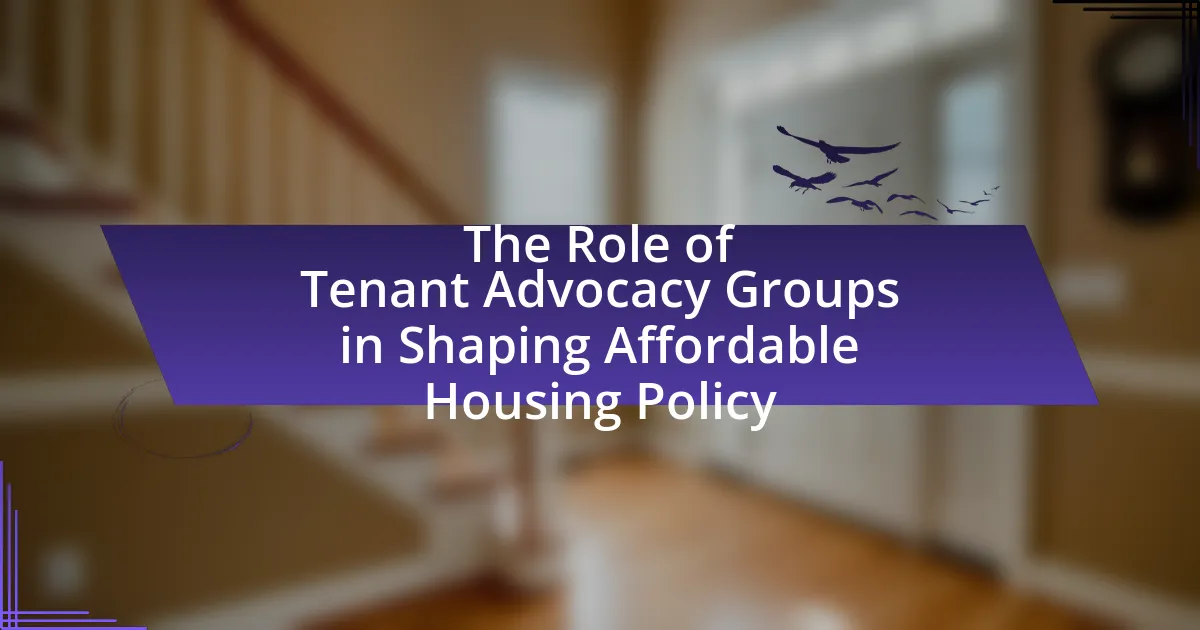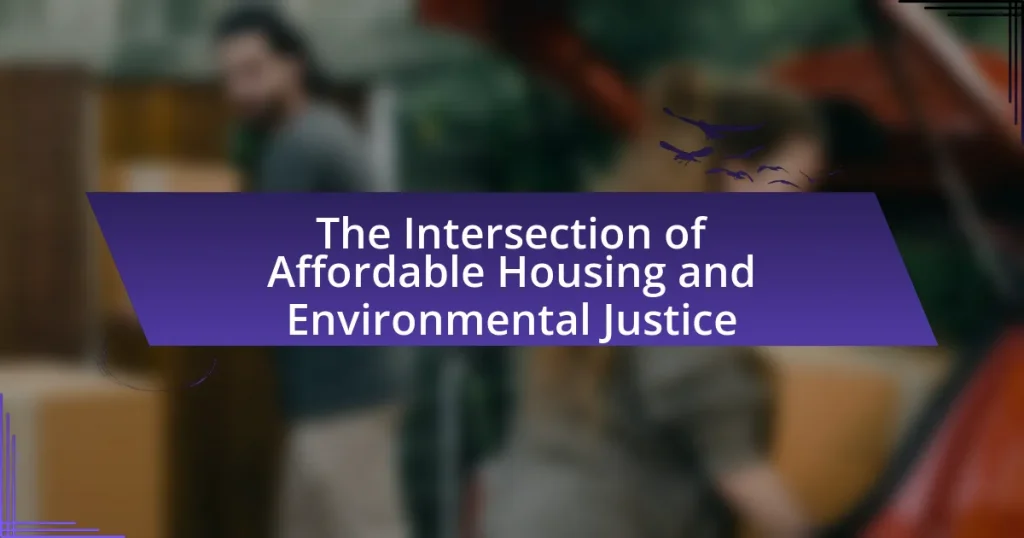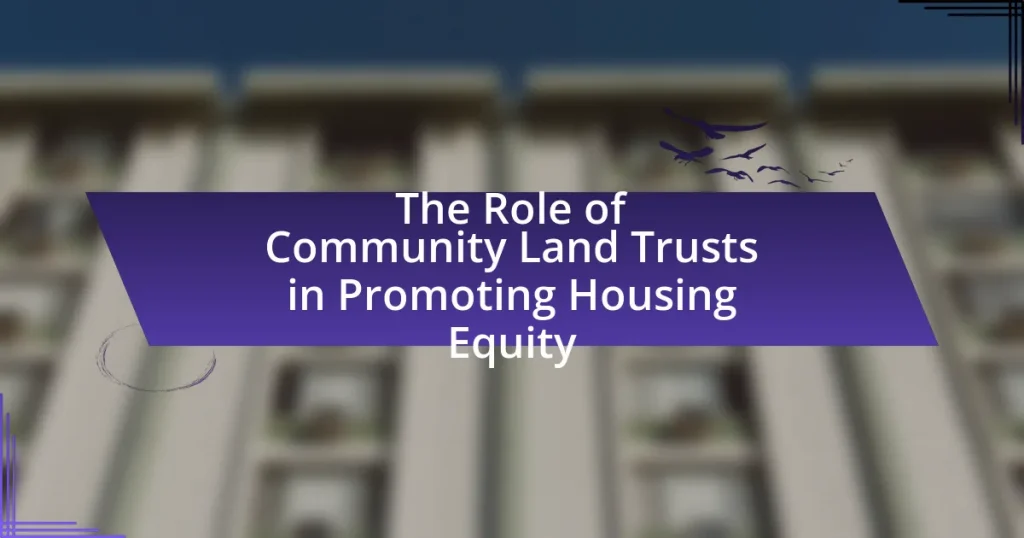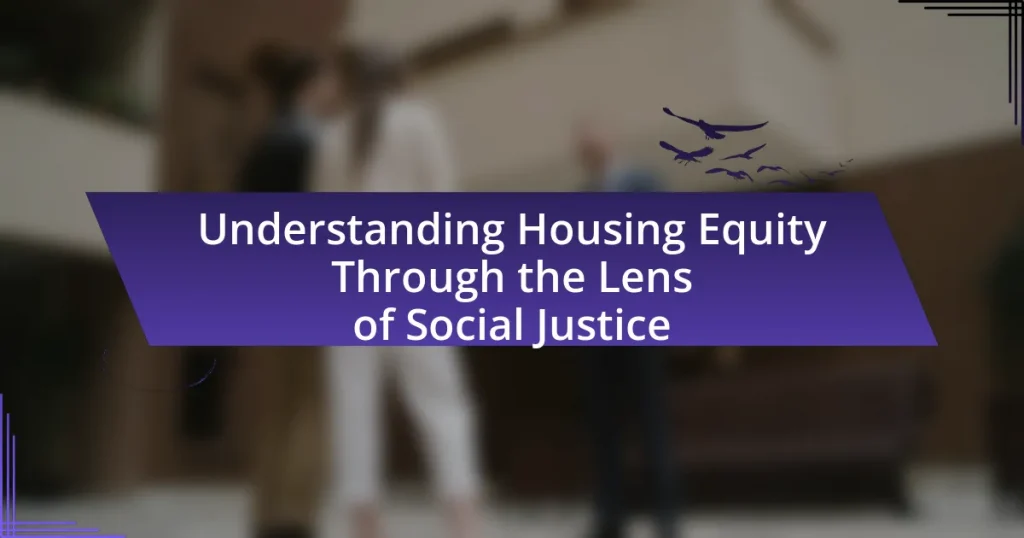Tenant advocacy groups are essential organizations that represent the interests of renters and significantly influence affordable housing policy. They mobilize community support, conduct research, and lobby for legislative changes that prioritize tenant rights and access to affordable housing. The article explores the various strategies employed by these groups, such as grassroots organizing and coalition building, and highlights the challenges they face, including limited funding and political resistance. Additionally, it discusses the impact of tenant advocacy on local housing policies and the importance of public awareness in supporting their initiatives. Through effective advocacy, these groups work to address the challenges tenants face, empower marginalized communities, and promote equitable housing solutions.

What is the role of tenant advocacy groups in shaping affordable housing policy?
Tenant advocacy groups play a crucial role in shaping affordable housing policy by representing the interests of renters and influencing legislative decisions. These organizations mobilize community members, conduct research, and provide data-driven recommendations to policymakers, thereby ensuring that the voices of tenants are heard in discussions about housing regulations and funding. For instance, tenant advocacy groups have successfully lobbied for rent control measures and increased funding for affordable housing initiatives in various cities, demonstrating their impact on policy outcomes. Their efforts often lead to the implementation of policies that prioritize tenant rights and affordable housing access, reflecting the needs of low- and moderate-income families.
How do tenant advocacy groups influence housing legislation?
Tenant advocacy groups influence housing legislation by mobilizing community support, conducting research, and lobbying policymakers. These organizations often represent the interests of renters, providing data on housing needs and advocating for policies that promote affordable housing. For instance, the National Low Income Housing Coalition regularly publishes reports highlighting the gap between wages and housing costs, which informs legislative discussions. Additionally, tenant advocacy groups organize campaigns and public demonstrations to raise awareness and pressure lawmakers to enact tenant-friendly laws, such as rent control measures or eviction protections. Their ability to engage constituents and present compelling evidence makes them a significant force in shaping housing policy.
What strategies do tenant advocacy groups employ to advocate for affordable housing?
Tenant advocacy groups employ various strategies to advocate for affordable housing, including grassroots organizing, policy advocacy, and coalition building. Grassroots organizing involves mobilizing community members to raise awareness about housing issues and to participate in demonstrations or public meetings, which can influence local government decisions. Policy advocacy focuses on lobbying for legislation that supports affordable housing initiatives, such as rent control or increased funding for public housing. Coalition building brings together diverse stakeholders, including other advocacy groups, local businesses, and residents, to create a united front that amplifies their message and increases their influence on policymakers. These strategies are supported by evidence showing that organized community efforts can lead to significant policy changes, as seen in cities where tenant groups successfully campaigned for rent stabilization laws.
How do these strategies vary by region or community?
Tenant advocacy strategies vary significantly by region and community due to differing local housing markets, political climates, and demographic needs. For instance, urban areas with high demand for affordable housing, such as New York City, often focus on rent stabilization and tenant protections, while rural communities may prioritize access to housing development and zoning reforms. Additionally, advocacy groups in regions with strong tenant rights laws, like California, may employ litigation and policy lobbying more aggressively compared to areas with weaker protections, where grassroots organizing and community outreach become essential. These variations are supported by data indicating that regions with higher housing costs tend to see more robust tenant advocacy efforts aimed at legislative change, reflecting the unique challenges faced by their communities.
Why are tenant advocacy groups essential in the affordable housing landscape?
Tenant advocacy groups are essential in the affordable housing landscape because they represent the interests of low-income renters and work to influence housing policy. These groups provide a voice for tenants, ensuring their concerns about affordability, discrimination, and housing conditions are heard by policymakers. For instance, according to the National Low Income Housing Coalition, advocacy efforts have led to increased funding for affordable housing programs and the implementation of tenant protections in various states. By mobilizing community support and conducting research, tenant advocacy groups play a critical role in shaping legislation that addresses housing inequities and promotes access to safe, affordable housing for all.
What challenges do tenants face that advocacy groups address?
Tenants face several challenges that advocacy groups address, including eviction threats, rent increases, and unsafe living conditions. Advocacy groups work to protect tenants’ rights by providing legal assistance, negotiating with landlords, and raising awareness about housing policies. For instance, according to the National Low Income Housing Coalition, nearly 70% of low-income renters experience housing instability, highlighting the critical role of advocacy in addressing these issues.
How do tenant advocacy groups empower marginalized communities?
Tenant advocacy groups empower marginalized communities by providing resources, education, and representation in housing matters. These organizations facilitate access to legal assistance, helping tenants understand their rights and navigate complex housing laws. For instance, studies show that areas with active tenant advocacy groups experience lower eviction rates, indicating their effectiveness in protecting vulnerable populations. Additionally, these groups often mobilize community members to advocate for policy changes, ensuring that the voices of marginalized communities are heard in local government decisions regarding affordable housing. This collective action can lead to the implementation of more equitable housing policies that directly benefit these communities.
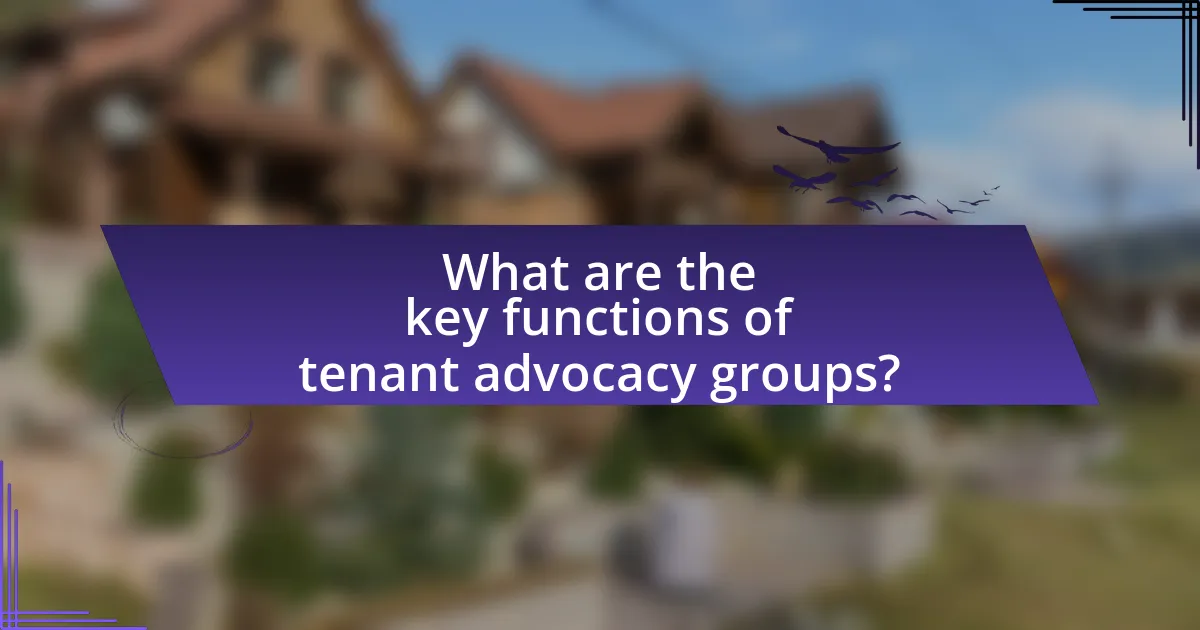
What are the key functions of tenant advocacy groups?
Tenant advocacy groups primarily function to represent the interests of renters, ensuring their rights are protected and promoting affordable housing policies. These organizations engage in activities such as providing legal assistance, educating tenants about their rights, and lobbying for legislative changes that benefit renters. For instance, according to the National Low Income Housing Coalition, tenant advocacy groups have successfully influenced policies that increase funding for affordable housing and protect against unjust evictions. Additionally, they often facilitate community organizing efforts, empowering tenants to collectively address issues related to housing stability and quality.
How do tenant advocacy groups educate tenants about their rights?
Tenant advocacy groups educate tenants about their rights through workshops, informational materials, and direct legal assistance. These organizations often conduct community outreach programs that provide tenants with essential knowledge regarding local housing laws, tenant protections, and the eviction process. For example, the National Low Income Housing Coalition offers resources and guides that detail tenant rights in various states, ensuring that tenants are informed about their legal standing. Additionally, many advocacy groups collaborate with legal professionals to offer free or low-cost legal clinics, where tenants can receive personalized advice and support. This multifaceted approach empowers tenants to understand and assert their rights effectively.
What resources do these groups provide to tenants?
Tenant advocacy groups provide various resources to tenants, including legal assistance, educational workshops, and access to financial aid programs. These resources help tenants understand their rights, navigate housing issues, and secure affordable housing options. For instance, many advocacy groups offer free legal consultations to assist tenants facing eviction or discrimination, which is crucial given that approximately 3.7 million eviction cases are filed annually in the United States. Additionally, educational workshops inform tenants about lease agreements and tenant rights, empowering them to advocate for themselves. Financial aid programs, often facilitated by these groups, can help tenants cover rent or utility costs, particularly during economic hardships.
How effective are these educational efforts in improving tenant awareness?
Educational efforts by tenant advocacy groups are highly effective in improving tenant awareness. These initiatives often include workshops, informational materials, and community outreach programs that educate tenants about their rights and available resources. Research conducted by the National Low Income Housing Coalition indicates that tenants who participate in educational programs report a 40% increase in knowledge regarding their rights and responsibilities. This heightened awareness leads to more informed decision-making and greater engagement in housing policy discussions, ultimately empowering tenants to advocate for their needs and influence affordable housing policies.
What role do tenant advocacy groups play in community organizing?
Tenant advocacy groups play a crucial role in community organizing by mobilizing residents to advocate for their rights and improve housing conditions. These groups educate tenants about their legal rights, provide resources for collective action, and facilitate communication between tenants and policymakers. For instance, organizations like the Tenants Union in Seattle have successfully organized campaigns that led to the implementation of rent control measures and tenant protections, demonstrating their effectiveness in influencing housing policy.
How do these groups mobilize tenants for collective action?
Tenant advocacy groups mobilize tenants for collective action by organizing community meetings, providing education on tenant rights, and facilitating communication among tenants. These groups often utilize grassroots strategies to build solidarity, such as door-to-door outreach and social media campaigns, which help to raise awareness about housing issues and encourage participation in collective efforts. For instance, studies have shown that organized tenant associations can lead to successful negotiations with landlords and policymakers, demonstrating the effectiveness of collective action in achieving housing stability and policy changes.
What impact does community organizing have on local housing policies?
Community organizing significantly influences local housing policies by mobilizing residents to advocate for their housing needs and rights. This grassroots effort often leads to the implementation of policies that prioritize affordable housing, tenant protections, and equitable development. For instance, studies have shown that organized tenant groups can effectively lobby for rent control measures and zoning reforms, resulting in increased access to affordable housing options. Research conducted by the National Low Income Housing Coalition indicates that communities with active tenant advocacy groups are more likely to see legislative changes that address housing insecurity and promote tenant rights.

What are the challenges faced by tenant advocacy groups?
Tenant advocacy groups face several challenges, including limited funding, political resistance, and the complexity of housing laws. Limited funding restricts their ability to effectively mobilize resources and reach tenants in need, as many rely on donations and grants that may not be sufficient. Political resistance often arises from landlords and property owners who oppose regulations that tenant advocacy groups support, making it difficult to enact favorable policies. Additionally, the complexity of housing laws can hinder these groups’ efforts to educate tenants about their rights and navigate legal processes, as many tenants may lack the knowledge or resources to advocate for themselves effectively.
How do funding and resource limitations affect tenant advocacy groups?
Funding and resource limitations significantly hinder tenant advocacy groups by restricting their ability to effectively represent tenants’ interests. These limitations often result in reduced staffing, which diminishes the capacity to conduct outreach, provide legal assistance, and mobilize community support. For instance, a study by the National Low Income Housing Coalition found that many advocacy groups operate on tight budgets, leading to fewer resources for essential activities such as organizing campaigns and conducting research on housing policies. Consequently, the lack of funding can weaken their influence in policy discussions and limit their effectiveness in advocating for affordable housing solutions.
What strategies can advocacy groups use to overcome these challenges?
Advocacy groups can employ strategies such as coalition building, grassroots mobilization, and data-driven advocacy to overcome challenges in shaping affordable housing policy. Coalition building allows these groups to unite various stakeholders, enhancing their influence and resources. Grassroots mobilization engages community members, fostering a strong base of support that can pressure policymakers. Data-driven advocacy utilizes research and statistics to present compelling arguments, demonstrating the need for affordable housing initiatives. For instance, a report from the National Low Income Housing Coalition highlights that 71% of extremely low-income renters face severe housing cost burdens, providing a factual basis for advocacy efforts.
How do political climates influence the effectiveness of tenant advocacy groups?
Political climates significantly influence the effectiveness of tenant advocacy groups by shaping the legal and social environment in which these organizations operate. In supportive political climates, tenant advocacy groups can secure favorable legislation, access funding, and mobilize community support, leading to successful initiatives such as rent control measures or tenant protection laws. For instance, during the 2019 New York State legislative session, a progressive political climate enabled tenant advocacy groups to achieve significant reforms, including the strengthening of rent regulations, which directly benefited millions of renters. Conversely, in hostile political climates, these groups may face legislative pushback, reduced funding, and increased challenges in mobilizing support, which can hinder their ability to advocate effectively for tenant rights and affordable housing policies.
What are the potential solutions to enhance the impact of tenant advocacy groups?
To enhance the impact of tenant advocacy groups, increasing funding and resources is essential. Adequate financial support allows these groups to expand their outreach, conduct research, and provide legal assistance to tenants. For instance, studies show that organizations with robust funding can engage in more effective lobbying efforts, resulting in significant policy changes, such as rent control measures in cities like New York and San Francisco. Additionally, fostering partnerships with other community organizations can amplify their voice and influence, as seen in successful coalitions that have advocated for tenant rights across various states.
How can collaboration with other organizations strengthen advocacy efforts?
Collaboration with other organizations can significantly strengthen advocacy efforts by pooling resources, expertise, and networks to amplify the impact of campaigns. When tenant advocacy groups partner with housing nonprofits, legal aid organizations, and community groups, they can leverage diverse skill sets and knowledge bases, leading to more comprehensive strategies. For instance, a study by the National Low Income Housing Coalition found that coalitions of advocacy groups were more effective in influencing policy changes, as they could present unified positions and mobilize larger constituencies. This collective action not only enhances visibility but also increases the likelihood of achieving legislative goals, as seen in successful campaigns for affordable housing reforms in various cities.
What role does public awareness play in supporting tenant advocacy initiatives?
Public awareness is crucial in supporting tenant advocacy initiatives as it mobilizes community support and influences policy changes. Increased awareness about tenant rights and housing issues leads to greater public engagement, which can pressure local governments to address housing policies. For instance, studies show that campaigns raising awareness about eviction rates have resulted in legislative reforms in various cities, highlighting the direct impact of informed public opinion on housing policy.
What best practices can tenant advocacy groups adopt for effective advocacy?
Tenant advocacy groups can adopt several best practices for effective advocacy, including building strong coalitions, engaging in data-driven campaigns, and prioritizing tenant education. Strong coalitions enhance collective bargaining power, as evidenced by successful partnerships in cities like San Francisco, where tenant organizations collaborated with labor unions to influence housing policy. Data-driven campaigns, supported by research from organizations like the National Low Income Housing Coalition, demonstrate the impact of housing instability on communities, making a compelling case for policy changes. Additionally, prioritizing tenant education empowers individuals to understand their rights and advocate for themselves, which has been shown to increase participation in advocacy efforts and improve outcomes in housing negotiations.
How can tenant advocacy groups measure their success in influencing policy?
Tenant advocacy groups can measure their success in influencing policy through specific metrics such as the number of legislative changes they successfully advocate for, the implementation of tenant-friendly policies, and increased funding for affordable housing initiatives. For instance, if a tenant advocacy group successfully lobbies for rent control legislation, the passage of that law serves as a direct indicator of their influence. Additionally, tracking the number of tenants who benefit from new policies, such as eviction protections or housing subsidies, provides concrete evidence of their impact. Research shows that advocacy efforts can lead to significant policy shifts; for example, a study by the National Low Income Housing Coalition found that states with active tenant advocacy groups are more likely to adopt progressive housing policies.
What innovative approaches can be utilized to engage tenants in advocacy efforts?
Innovative approaches to engage tenants in advocacy efforts include utilizing digital platforms for communication and organizing, implementing participatory budgeting processes, and fostering community partnerships. Digital platforms, such as social media and mobile apps, enable tenants to share experiences, mobilize support, and coordinate actions efficiently, as evidenced by the success of campaigns like #RentStrike, which gained traction through online engagement. Participatory budgeting allows tenants to have a direct say in how funds are allocated for community improvements, enhancing their investment in advocacy outcomes. Additionally, partnerships with local organizations can amplify tenants’ voices and provide resources for education and outreach, as demonstrated by initiatives like the Tenant Advocacy Network, which connects tenants with legal resources and advocacy training. These methods not only empower tenants but also create a more inclusive dialogue around affordable housing policy.
